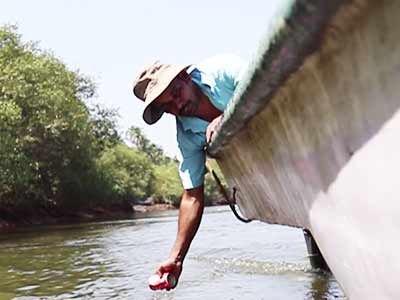
Khazan ecosystems are reclaimed wetlands and mangrove areas, where tidal influence is regulated by the construction of embankments and sluice gates. 'Khazans' in Goa have always been nature's defence to its own excesses such as high tides, storms or floods. They are predominantly rice and fish fields. Traditionally, Khazans have a very simple architectural design using locally available low-cost resources, which is in use for more than last 3,500 years with low running cost. Through biogeochemical cycling of nutrients the vegetation in khazans help in treating large volumes of organic waste, purifying water and returning the nutrients back to the soil, thus preserving soil quality. Among the list of benefits that these treasure lands offer, only a few have been mentioned here.


However, with increasing lack of awareness through generations, and the need to earn better livelihood, large tracts of these wonderlands are being used for different purposes. The khazans have been traditionally protected and used by local communities, but booming tourism sector has led to significant portions being sold to developers who fill up the watery tracts and firm up the soil layer to lay foundation for buildings to be constructed. These new concrete structures have not only taken away a precious biodiversity spot, but also posed themselves the risk of flooding in the absence of these natural tide and wave barriers.
If not given away to builders, then these khazans are increasingly used for pisciculture throughout the year. Instead of paddy farming, which has traditionally been the main activity in khazan areas, farmers are turning towards farming fish, driven by market forces that offer better price for fish than paddy. Consequently, sluice gates which are normally part of this ecosystem, are opened for inflow of water which floods the land and allows for breeding fish. While this does allow the local communities to enhance their livelihoods, it permanently damages the soil quality by infusing salinity. And again, when the storm hits there is no respite to the neighbourhoods from wind and water.
The khazans are fast losing their ground, but there is one village which has continued to preserve these precious lands and along with it the immensely rich diversity of flora and fauna in those areas. Chodan-Madel has emerged as a fine example of how communities have strived to preserve the traditional ways. This is an island which is the largest amongst the estuarine islands of Goa. Two of its most important ecosystems are mangroves and khazans. Communities here have not only protected several of their important historical, socio-cultural and religious sites and structures through centuries, they have also passed on their knowledge of preserving the flora and fauna of this place. Chodan-Madel is one of the few places where local species of plants and animals still exist in complete harmony with the people living here.
With the aim of studying the feasibility of these sites within the village designated as Biodiversity Heritage Sites (BHS), a team from The Energy and Resources Institute carried out the assessment. The site visit revealed some commendable practices by the community. Along with paddy cultivation, which is the mainstay of these khazans, winter vegetables are also grown. While salt tolerance is not a commonly observed feature of paddy, these are indigenous varieties which over a long period have developed resistance to pests and salinity. Traditional aquaculture practised in the poiem, a component of the khazans, also contributes to the agro biodiversity of the island.
The khazans blend in a highly harmonious manner with the local people, animals, plants, land, and water. The intricate system of mangrove vegetation, khazans, poiem, and plantations of varieties of mango, cashew, coconut and teak, provide nesting, feeding and breeding grounds to a wide variety of fauna, both resident and migratory. The presence of Dr. Salim Ali Bird Sanctuary on the island adds to the diversity of birds.
The co-existing mosaic of natural, semi-natural, and man-made habitats, as depicted by the khazans and mangroves of Chodan-Madel; the diverse domesticated flora, as well as the large numbers of varieties observed among several crop species on the island; and the provision of refuge to migratory and resident species, especially those that are threatened or endemic, are factors that strongly indicate that sites on Chodan-Madel have the potential to be declared as BHS. And, if it does, it will become an inspiration for other communities to follow suit and conserve a precious historical, natural and social heritage of Goa.


